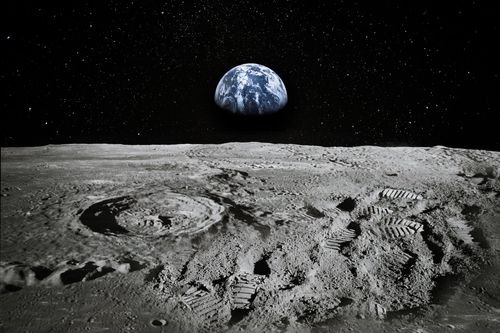NASA is paying startups for moon rocks. It’s not what you think

How much is a moon rock worth? According to new contracts inked between NASA and four startups, it’s somewhere between $1 and $15,000.
NASA pledged in September to buy moon rocks from companies that can get robotic rovers to the lunar surface and scoop up samples of the dusty terrain, and the space agency asked for bids from companies all over the world. The winners were unveiled Thursday: California-based Masten, Lunar Outpost of Colorado, and two separate companies that are both called iSpace — one from Japan and the other from Luxembourg.
The program, which NASA hopes will be completed by 2024, the same year the agency hopes to return astronauts to the moon, is among the most unique in US history. The goal is not to glean new information about lunar soil composition or study how various lunar resources can be used. The goal, rather, is to encourage the private sector to invest in rover development.
And perhaps the primary goal of the project is to make clear to the rest of the world that the moon is not just a place for exploration and research — it’s a place of business.
NASA may be the only organization that’s currently in the market for buying moon rocks from private companies, but the space agency allowed the companies to name their price. Lunar Outpost pledged to sell their sample for just $1, by far the smallest bid. Both iSpace companies plan to sell their samples for $5,000. And Masten will sell its collection for $15,000.
It’s not yet clear if any of the companies will succeed in their efforts. NASA says it will only pay 10% of the total purchase price upfront. And yes, NASA plans to mail Lunar Outpost’s a check for 10¢, according to Phil McAlister, NASA’s director of commercial spaceflight development. The companies will receive another 10% after their rovers launch into space, and the final 80% will be paid out after the companies prove to NASA that their rovers have actually collected lunar soil samples of between 50 and 500 grams, or up to about a pound when weighed on Earth.
The trek to the moon is not easy. The companies will need to buy a ride on a rocket that can carry their rovers all the way to the moon, and they’ll need a lunar lander which can ferry the rovers down to the lunar surface. But if the rovers can get there, the companies will not be required to bring the soil samples they collect back to Earth. McAlister said it’s also unclear if NASA plans to bring them home at all because that’s not the point of the program.
“We think it’s very important to establish the precedent that private-sector entities can extract these resources and NASA can purchase” them, NASA executive Mike Gold told reporters Thursday.
The economic incentive for the four companies signed up for NASA’s new lunar resource program is not exactly clear, but all of the companies are already well underway developing various lunar exploration technologies.
Masten, for example, has a $75.9 million contract with NASA through a different program, dubbed CLPS, to deliver supplies to the moon in 2022 using its XL-1 lunar lander.
The “lasting impact of today’s news that NASA is purchasing moon Dirt from Masten is about knocking down uncertainty & risks that make economic activity beyond earth too risky to act upon,” read a tweet posted to the company’s account. “Today’s Lunar Regolith Purchase is small measured in dollars, but monumental measured in impact on unlocking the value of space for humanity.”
Lunar Outpost also has a separate contract with the Department of Defense for its lunar rover, called MAPP, that’s designed to survey the lunar surface using scientific instruments.
The company also described its interest in the resource recovery program — and its $1 bid — as a stepping stone toward more extraterrestrial business opportunities.
“NASA and Lunar Outpost will work in conjunction to begin the process of developing the legal and logistical framework for future space resource acquisition contracts,” a company press release states.
That will be key for spurring investments in space exploration, according to NASA. And, ultimately, learning how to use lunar resources to support a permanent human presence on the moon, which is the stated goal of NASA’s Artemis program.
What selling Moon rocks will mean
The United States made it clear in recent years that it aims to create an extraterrestrial economy, one that relies as much on building a private-sector presence in outer space as fulfilling science and research goals. But plans to mine resources on the moon are controversial.
Some scientists fear that excessive business activity could contaminate or destroy areas of the moon that could provide key clues about how the moon — and the Earth — were formed.
Stuart Clark, a PhD astronomer, lamented in Britain’s Science Focus magazine earlier this year that mining lunar resources could lead to a “gold rush” fueled by a “winner-takes-all mentality,” and scientists will lose out on “valuable geological clues.”
“Very few countries, it seems, are willing to sign away their profits for the common good,” he wrote.
Others argue that commercializing space exploration can be a win-win.
“It’s important that we balance, moving forward together in a way that will enable this [lunar] economy as well as the science,” said Clive Neal, an engineering professor at the University of Notre Dame. “My way of looking at this is that if we look at moon resources as resources for science, and a resource for exploration, and a resource for commercial participation everybody wins because the data sets that we need are pretty much the same.”
It should be noted that NASA’s resource extraction program will involve digging up very small amounts of the lunar surface.
What lunar resources can be used for
Apart from studying lunar soil for scientific purposes, researchers hope that resources found on the moon can help support future astronauts who live and work at a lunar outpost. The moon’s water ice, for example, can be converted to drinking water.
Water ice can also be turned into rocket fuel, which could be used to power missions deeper into the solar system. Some researchers are also hopeful that Helium-3, a version of helium that is rare on earth but abundant on the moon, could be used to produce massive amounts of energy via nuclear fusion.
Still, many experts are skeptical of the idea that these opportunities can draw — and sustain — private-sector interest.
Alice Gorman, a leading space archeology expert, argued in a recent interview with Space Watch Global that the United States that there’s a lot of “unjustified optimism there given the technical challenges of extracting and using resources on the moon.”




